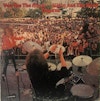Memory is a tricky thing, especially when you’ve executed (happily, even when torturous) countless interviews where thousands of voices beyond your own (okay, my own) boil over and blur into one surreal cauldron. Years of conversations you’ve had with lovers, haters, friends, and family blend seamlessly into those you’ve had with strangers. Speaking to that, my interviews with Aphex Twin’s Richard James for various magazines at the top of the ’90s (three, if remembered correctly) are missing and gone. Paper deteriorates. Early ’90s computer technology can’t be read—talk to anyone with floppy discs or DATs. Google isn’t the completist you’ve imagined.
What’s recalled, then, about speaking to the mostly quiet, boy-genius James—first—around the time of his immediate Aphex Twin classic Selected Ambient Works 85–92 was that he sought to move from his start having all but created Brit acid house into a brand of miniaturized abstract and ambient soundscape by 1992. Not unlike Brian Eno’s brief blips that filled the sinister, imaginary Music for Films, A-Twin’s Selected Ambient Works 85–92 was ripe with flanged and emotive squiggles of collage-like environments and phase-shifting mini-worlds within other weirder worlds. What made James’s tape-fluctuated Works work, so uniquely, was the manner in which he altered his own equipment in his Cornwall bedsit. Such customization made it that every one moment—like live theater—was unrepeatable and unlike its next iteration.
The act of theater must have been a big concept for Aphex-James. Always quick to improvise his way into the next thing (see his moves into hard drilling drum & bass and jarring jungle on the Richard D. James Album), with many musical aliases (Caustic Window, Boy on Dope, Polygon Window) and plentiful masks, this guy could’ve been an actor. Morphing his beardo visage into something hideous or grafting his head onto women’s bodies for unknown effect was but one mysterious gender-baiting element of his aesthetic.
There was something of a reveal, however, that went with the sonic shifts of his first two Warp albums, 1995’s aggressive percussion-driven …I Care Because You Do and the hyper-breakbeaten, jagged jungle-filled Richard D. James Album of 1996. Having interviewed him again around this time, James was no more revealing in his conversation—beyond his tech—than he had been previously. But showing himself as easily influenced and willingly inspired by the music around him on the Richard D. James Album proves how Aphex Twin was openly receptive, and something of a lightning rod. (You could also look at this cynically as someone bereft of direction, or struck by writer’s block as David Bowie was a year later by releasing his own jungle effort, Earthling.)
Both featuring James self-portraits—one illustrated and exaggerated, one photographed with a maniacal toothy grin—the illusion created is one of personal revelation, of something naked and honest, even if he looks bent and mean. Plus, no joke, early limited editions of James’s eponymously titled album came with a plastic baggie filled with a lock of James’s hair. That’s a tell. Yet, to a guy with a dozen aliases, what’s in a tell or a name, even if it’s one you were born with?
The rare but creeping influence of other mid-’90s electronic music contemporaries such as the jazzily complex Squarepusher and the techno trip-hopping Luke Vibert show a differing strain of honesty for James. The art of obvious inspiration, especially by those immediately around him (Squarepusher was actually then a new signee to Aphex’s Rephlex label) was a form of open communion. Squarepusher’s own sound—the progressive rock version of jungle with its overly ornate and complex bridges, outre rhythmic passages (his live instrumental specialty was bass) and veers into the electro-acoustic—was like honey to Aphex Twin. So too was Squarepusher’s reach into the clean, clarity of digital music making.
The all-digital creation/production of the Richard D. James Album (…I Care was Aphex’s last album recorded with analog technology as its guiding force) was executed exclusively by Aphex Twin (credited as “Me”) right down to the album’s cover. Like 1995’s …I Care, Richard D. James Album’s elegant and highly composed melodies are beautiful, lush, cleanly orchestrated and even fragile. The inspirations are wide-ranging and diverse, touching on elements of jazz, classical, and traditional lullabies—enough so to allow Aphex Twin his first straightforward vocal moment on “Milkman.” But like the harshest of Squarepusher’s most complicated tracks, Aphex Twin’s 1996 album is brutal and occasionally jack-hammering-ly violent while maintaining a high profile of contagion and gentility. For all its vicious, slamming rhythms and harsh, harrowing speeds, the Richard D. James Album is Aphex Twin’s most easily accessible full-length—a raw, but eloquent record that welcomes the listener with his most warmly inviting melodies, then slaps them around, tweaks their earlobes, and kicks out their balance from under them.
Back in the day, James’s Rephlex Records gave Aphex Twin its own brand name, braindance, with the claim that his was a self-made genre that encompassed “the best elements of all genres, e.g., traditional, classical, electronic music, popular, modern, industrial, ambient, hip-hop, electro, house, techno, breakbeat, hardcore, ragga, garage, drum and bass, etc.” If any of his recordings intentionally encompassed such a credo, then soared far beyond such a mantra, it’s Aphex Twin’s Richard D. James Album. He probably told me all that. I just don’t remember.


